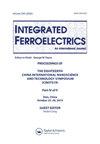PAMBE用TEM研究MgO(001)衬底上立方氮化镓沿[100]带轴的堆积缺陷
IF 0.7
4区 工程技术
Q4 ENGINEERING, ELECTRICAL & ELECTRONIC
引用次数: 0
摘要
摘要:利用等离子体辅助分子束外延(PAMBE)技术生长的立方氮化镓缓冲层两步生长在MgO(001)上,利用透射电镜(TEM)沿[100]带轴研究了立方氮化镓的明暗场结构。在立方AlN薄膜中观察到堆积缺陷特征的金字塔形对比。金字塔面对比度对应于(002)面和(111)面,沿[100]方向有~ 45°投影。三维图形模型可以将金字塔对比结构缺陷解释为与文献中立方结构(002)与(111)夹角为~ 54.7°的[110]方向上观察到的金字塔对比结构相同。作者要感谢朱拉隆功大学90周年纪念基金(Ratchadaphiseksomphot Endowment Fund)、朱拉隆功大学博士生会议基金和朱拉隆功大学Ratchadaphiseksomphot捐赠基金(RES5605302227AM)的财政支持。披露声明作者未报告潜在利益冲突。本文章由计算机程序翻译,如有差异,请以英文原文为准。
TEM Investigation of Stacking Faults Defect Taken Along [100] Zone Axis of Cubic AlN on MgO (001) Substrate with Using 2-Step Growth Cubic GaN Buffer Layer by PAMBE
AbstractMicrostructures of cubic AlN on MgO (001) with using two-step growth of cubic GaN buffer layer grown by plasma assist molecular beam epitaxy (PAMBE) technique have been investigated by bright- and dark field cross section transmission electron microscopy (TEM) along [100] zone axis. The Pyramid shape contrast which has been proposed the characteristic of stacking faults defect was observed in cubic AlN film. Pyramid facet contrast correspond with (002) plane and (111) plane with ∼45° projection along [100] direction. The 3D graphic model can explain the Pyramid contrast structure defect as the same Pyramid contrast structure observed in [110] direction with the angle between (002) and (111) of cubic structure found ∼54.7° by the literature.Keywords: Cubic phaseAlNbuffer layerMBEstacking faultTEM AcknowledgementsThe authors would like to thank the 90th Anniversary of Chulalongkorn University Fund (Ratchadaphiseksomphot Endowment Fund), Conference Grant for Ph.D. Student Chulalongkorn University and Ratchadaphiseksomphot Endowment Fund of Chulalongkorn University (RES5605302227AM) for their financial support.Disclosure StatementNo potential conflict of interest was reported by the authors.
求助全文
通过发布文献求助,成功后即可免费获取论文全文。
去求助
来源期刊

Integrated Ferroelectrics
工程技术-工程:电子与电气
CiteScore
1.40
自引率
0.00%
发文量
179
审稿时长
3 months
期刊介绍:
Integrated Ferroelectrics provides an international, interdisciplinary forum for electronic engineers and physicists as well as process and systems engineers, ceramicists, and chemists who are involved in research, design, development, manufacturing and utilization of integrated ferroelectric devices. Such devices unite ferroelectric films and semiconductor integrated circuit chips. The result is a new family of electronic devices, which combine the unique nonvolatile memory, pyroelectric, piezoelectric, photorefractive, radiation-hard, acoustic and/or dielectric properties of ferroelectric materials with the dynamic memory, logic and/or amplification properties and miniaturization and low-cost advantages of semiconductor i.c. technology.
 求助内容:
求助内容: 应助结果提醒方式:
应助结果提醒方式:


